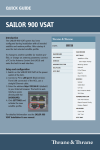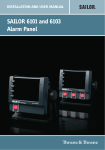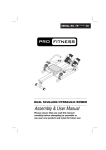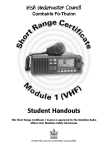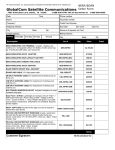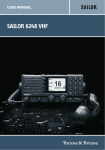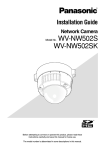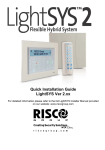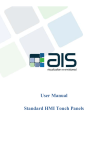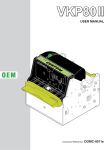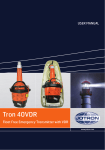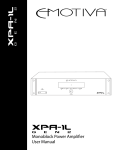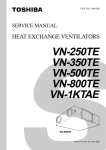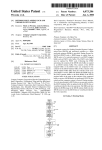Download SAILOR 6110 Installation
Transcript
INSTALLATION MANUAL SAILOR 6110 GMDSS System SAILOR 6110 GMDSS System Installation manual Document number: 98-130752-A Release date: December 22, 2010 Disclaimer Any responsibility or liability for loss or damage in connection with the use of this product and the accompanying documentation is disclaimed by Thrane & Thrane. The information in this manual is provided for information purposes only, is subject to change without notice and may contain errors or inaccuracies. Manuals issued by Thrane & Thrane are periodically revised and updated. Anyone relying on this information should acquire the most current version e.g. from http://www.thrane.com or from the distributor. Thrane & Thrane is not responsible for the content or accuracy of any translations or reproductions, in whole or in part, of this manual from any other source. Copyright © 2010 Thrane & Thrane A/S. All rights reserved. Trademark Acknowledgements • Thrane & Thrane is a registered trademark of Thrane & Thrane A/S in the European Union and the United States. • Inmarsat is a registered trademark of the International Maritime Satellite Organisation (IMSO) and is licensed by IMSO to Inmarsat Limited and Inmarsat Ventures plc. • SAILOR is a registered trademark of Thrane & Thrane A/S in the European Union, the United States and other countries. • Other product and company names mentioned in this manual may be trademarks or trade names of their respective owners. Safety summary 1 The following general safety precautions must be observed during all phases of operation, service and repair of this equipment. Failure to comply with these precautions or with specific warnings elsewhere in this manual violates safety standards of design, manufacture and intended use of the equipment. Thrane & Thrane assumes no liability for the customer's failure to comply with these requirements. Observe marked areas Under extreme heat conditions do not touch areas of units that are marked with this symbol, as it may result in injury. Microwave radiation hazards During transmission the antenna in this system radiates Microwave Power.This radiation may be hazardous to humans close to the antenna. When the system is powered, make sure that nobody gets closer than the recommended minimum safety distance of 0.3 meters (1 ft.). Keep away from live circuits Operating personnel must not remove equipment covers. Only qualified maintenance personal must make component replacement and internal adjustment. Under certain conditions, dangerous voltages may exist even with the cable removed. To avoid injuries, always disconnect power and discharge circuits before touching them. Compass safe distance Minimum safety distance: 5 m from the GMDSS Terminal. Failure to comply with the rules above will void the warranty! iii About the manual Intended readers This manual is an installation manual for the SAILOR 6110 GMDSS System. The manual is intended for installers of the system and service personnel. Personnel installing or servicing the system must be properly trained and authorized by Thrane & Thrane. It is important that you observe all safety requirements listed in the beginning of this manual, and install the system according to the guidelines in this manual. Manual overview Note that this manual does not cover how to use the system. For information on usage refer to the user manual. Part numbers for related manuals are listed in the next section. This manual has the following chapters: iv • Introduction contains an overview of the system. • Unpacking and activation describes initial inspection and explains how to activate the service. • Installing the system explains how to mount the units. • Connecting the system explains how to connect the units in the system and shows wiring, pin-out and cable requirements. • Installation check and test contains a check list for verifying the physical installation and guidelines for testing the installation. • Maintenance contains guidelines for handling, maintaining and repacking the SAILOR 6110 system. 2 Related documents The below list shows the documents related to this manual and to the SAILOR 6110 GMDSS System. Document number Ref Title and description [1] SAILOR 6110 GMDSS System, User manual 98-130753 [2] SAILOR 6006 and 6007 Message Terminal, Installation manual 98-130088 [3] SAILOR 6101 and 6103 Alarm Panel, Installation and user manual 98-130981 [4] SAILOR 6081 PSU and Charger, Installation and user manual 98-130980 [5] System 6000 Console, Installation manual 98-131571 [6] THRANE 6194 Terminal Control Unit, Installation and user manual 98-131593 v Typography In this manual, typography is used as indicated below: Bold is used for the following purposes: • To emphasize words. Example: “Do not touch the antenna”. • To indicate what the user should select in the user interface. Example: “Select SETTINGS > LAN”. Italic is used to emphasize the paragraph title in cross-references. Example: “For further information, see Connecting Cables on page...”. COURIER is used to indicate low level commands or text in the display. Example: “The display shows Distress”. vi Contents Chapter 1 Chapter 2 Introduction 1.1 SAILOR 6110 system overview .....................................2 1.2 SAILOR 3027 GMDSS Terminal ...................................3 1.3 SAILOR 6006 Message Terminal ................................4 1.4 SAILOR 6081 PSU and Charger ...................................5 1.5 SAILOR 1252 Printer ...................................................6 1.6 SAILOR 6197 Ethernet switch ......................................6 1.7 SAILOR 6101/6103 Alarm Panel ...................................7 1.8 SSA option .................................................................8 Unpacking and activation 2.1 Initial inspection ........................................................9 2.2 Registering your SAILOR 3027 .................................. 10 Chapter 3 Installing the system 3.1 General installation requirements .............................14 3.2 Mounting the SAILOR 3027 .......................................16 3.3 Mounting the SAILOR 1252 printer ........................... 23 Chapter 4 Connecting the system 4.1 Connecting the units ................................................ 27 4.2 Grounding the units ..................................................31 4.3 The CAN backbone ................................................... 33 4.4 Connecting power .................................................... 34 4.5 Connectors and pin-out ...........................................38 vii Contents Chapter 5 Installation check and test 5.1 Installation check list ...............................................47 5.2 Testing the system ...................................................49 5.3 Generating a diagnostic report .................................55 Chapter 6 Maintenance 6.1 Maintenance guidelines ...........................................57 6.2 Repacking for shipment .......................................... 58 6.3 Available parts .........................................................59 App. A Technical specifications A.1 SAILOR 6110 system specifications ............................ 61 A.2 SAILOR 3027 specifications .......................................62 Glossary .........................................................................................65 Index ........................................................................................ 69 viii 1111 Chapter 1 Introduction This chapter introduces the SAILOR 6110 system and briefly describes each unit in the system. It has the following sections: • SAILOR 6110 system overview • SAILOR 3027 GMDSS Terminal • SAILOR 6006 Message Terminal • SAILOR 6081 PSU and Charger • SAILOR 1252 Printer • SAILOR 6197 Ethernet switch • SAILOR 6101/6103 Alarm Panel • SSA option 1 Introduction 1 Chapter 1: Introduction 1.1 SAILOR 6110 system overview The drawing below shows an example of a SAILOR 6110 system. SAILOR 6110 GMDSS system SAILOR 3027 CAN Inline micro termination CAN 15 V DC SAILOR 6197 LAN SAILOR 6006 USB LAN SAILOR 6081 LAN SAILOR 6101/6103 SAILOR 1252 29 V DC The SAILOR 6110 is a Global Maritime Distress Safety System (GMDSS) used for sending and receiving messages and distress alerts through the Inmarsat C satellite network. Each unit is briefly described in the following sections. For a description of the services supported by the Inmarsat C system and the SAILOR 6110 system, see the user manual for the SAILOR 6110 GMDSS System [1]. 2 SAILOR 6110 system overview 1111 Chapter 1: Introduction Introduction 1.2 SAILOR 3027 GMDSS Terminal The SAILOR 3027 is a GMDSS approved Inmarsat GMDSS Terminal for the SAILOR 6110 system. It has a built-in LNA/HPA and an omni-directional antenna designed to operate on vessels. The housing is sealed and contains no user serviceable parts. The SAILOR 3027 is very compact and is designed to operate in extreme weather conditions. It has a highly sensitive built-in GPS module with 50 channels (Galileo ready). The antenna has an elevation angle of -15°, ensuring optimum communication even in rough weather. The SAILOR 3027 connects to other equipment using a CAN bus interface, capable of carrying power as well as bi-directional communication. For information on how to install the SAILOR 3027, see Mounting the SAILOR 3027 on page 16. SAILOR 3027 GMDSS Terminal 3 Chapter 1: Introduction 1.3 SAILOR 6006 Message Terminal The SAILOR 6006 Message Terminal is a GMDSS approved message terminal for the SAILOR 6110 system. With the SAILOR 6006 you can send distress alerts, read and write messages, monitor system status, change the configuration and test the system. The SAILOR 6006 has a Distress button for sending distress alerts. The SAILOR 6006 has a touch-screen interface and can be operated without a keyboard. However, a keyboard is mandatory in a GMDSS system. A CAN interface connects to the SAILOR 3027 GMDSS Terminal and an Ethernet interface connects to other equipment, such as alarm panels. For information on how to install the SAILOR 6006, see the installation manual enclosed with the SAILOR 6006 [2]. 4 SAILOR 6006 Message Terminal 1111 Chapter 1: Introduction Note Introduction 1.4 SAILOR 6081 PSU and Charger If you are using a different type of power supply than the SAILOR 6081, you must install a voltage monitor. The SAILOR 6081 PSU and Charger is used to supply power to the units in the SAILOR 6110 GMDSS System. It has five DC outputs of 24 V DC to 31.5 V DC (nominal 29 V DC) each and provides 300 W continuous (370 W peak). It also has a 15 V DC output, which should be used to supply power to the GMDSS Terminal through the CAN bus. The SAILOR 6081 PSU and Charger provides automatic switch-over to a connected backup battery if 115/230 VAC is not available. It also has a charger function for charging the battery when 115/230 VAC is available. Note that a backup battery is mandatory in the GMDSS System. On the SAILOR 6006 you can read status information such as AC alarm, backup battery status and other status information from the SAILOR 6081, through the Ethernet connection. For further information on the SAILOR 6081, see the manual enclosed with the SAILOR 6081 [4]. SAILOR 6081 PSU and Charger 5 Chapter 1: Introduction 1.5 SAILOR 1252 Printer The SAILOR 1252 printer is a standard matrix printer which connects to one of the USB connectors on the SAILOR 6006. In the SAILOR 6110 system it is primarily used to print SafetyNet EGCs with Distress priority. 1.6 SAILOR 6197 Ethernet switch The Ethernet switch connects the system units that have an Ethernet interface. In the SAILOR 6110 system, the local network is primarily used for monitoring purposes, alarm reporting and service. 6 SAILOR 1252 Printer 1111 Chapter 1: Introduction Introduction 1.7 SAILOR 6101/6103 Alarm Panel In addition to the Distress button on the SAILOR 6006, you must have one more distress button in order to comply with GMDSS regulations. For this purpose you can use an alarm panel. Two types of alarm panel are available from Thrane & Thrane: • SAILOR 6101 Alarm Panel This SAILOR 6101 has one Distress button, used for remote initiation of distress alert transmissions and for indication of incoming distress and urgency messages on Inmarsat-C GMDSS systems. • SAILOR 6103 Multi Alarm Panel Like the SAILOR 6101, the SAILOR 6103 is also used for remote initiation of distress alert transmissions and for indication of incoming distress and urgency messages, but the SAILOR 6103 is designed for use with both VHF, MF/HF and Inmarsat-C and has 3 Distress buttons, one for each system. For further information on the SAILOR 6101/6103, see the manual enclosed with your alarm panel [3]. SAILOR 6101/6103 Alarm Panel 7 Chapter 1: Introduction 1.8 SSA option The Ship Security Alert System provides ships with alarm buttons, which can be activated in case of a piracy or terrorist attack. The alarm is a covert signal that has no sound and no flashing lights, so it is not seen nor heard by any intruders on board the ship. The SSA option consists of three SSA buttons (two alarm buttons and one test button). It connects to the SAILOR 6110 system through the THRANE 6194 Terminal Control Unit. The CAN interface, which connects the SAILOR 6110 system to the THRANE 6194, also provides the power for the SSA option. SAILOR 6110 GMDSS system with SSA THRANE 6194 SAILOR 3027 LAN CAN CAN SAILOR 6100-913 SSA Kit/ SAILOR 6100-916 SSA US Kit 15 V DC LAN SAILOR 6006 LAN USB SAILOR 6081 SAILOR 6197 LAN LAN SAILOR 6101/6103 SAILOR 1252 29 V DC The GMDSS Terminal must be configured with the recipient(s) of the Ship Security Alert. For further information on the SSA option, refer to the manual for the THRANE 6194 [6]. 8 SSA option 2 Unpacking and activation Unpacking and activation 2222 Chapter 2 This chapter describes initial inspection of the SAILOR 6110 system and provides information on how to register the system for service activation. It has the following sections: • Initial inspection • Registering your SAILOR 3027 2.1 Initial inspection Inspect the shipping carton immediately upon receipt for evidence of damage during the transport. If the shipping carton is severely damaged or water stained, request the carrier's agent to be present when opening the carton. Save the carton and packing material for future use. Warning! To avoid hazardous electric shock, do not perform electrical tests if there is any sign of shipping damage to the outer cover. Read the safety summary at the front of this manual before installing or operating the SAILOR 6110 system. Check that the contents of the shipment are as listed in the enclosed packing list. If the contents are incomplete, if there is mechanical damage or defect, or if the system components do not work properly, notify your dealer. After you unpack the system do as follows: • Inspect the system thoroughly for hidden damaged or loose components or fittings. • Inspect the cable harness for stress, loose or broken wires, and broken cable ties. • Examine all the components for loose or missing hardware. • Fasten any loose hardware. 9 Chapter 2: Unpacking and activation 2.2 Registering your SAILOR 3027 2.2.1 Service Activation Registration Form Before using the SAILOR 3027 GMDSS Terminal on the Inmarsat C system you must register the terminal to the system. Note In most cases the distributor registers the system for the customer. For this purpose, use the SARF (Service Activation Registration Form) supplied with the SAILOR 3027. A copy of page 1 of the SARF is shown in the next page. As a guide, some of the most important fields are filled in with red color. The SARF for registration of Maritime MES (Mobile Earth Station - in this case the SAILOR 3027) can also be found on www.inmarsat.com/Support under Activation, including notes on how to complete the maritime form. The Service Activation Registration Form contains different abbreviations that are explained here. The SAILOR 3027 must be registered at either a PSA company or directly to the ISP. A PSA is a company handling the activation of Inmarsat mobiles and is short for Point of Service Activation. ISP is the company that provides the Inmarsat service and is short for Inmarsat Service Provider. In many cases the PSA and ISP is the same company that also operates a Land Earth Station (LES). The local PSA or ISP can be obtained by following the guidelines in the registration form. The Service Activation Registration Form also includes information needed to find out how to pay the bill for the Inmarsat C service. This payment will be made directly to the Accounting Authority. In many cases the Accounting Authority (AA) is also the same company as the Inmarsat Service Provider (ISP). In addition to the general information like name, address, etc. the ISN of the SAILOR 3027 must be specified. The ISN is found on the Delivery Note and on the label in the bottom of the SAILOR 3027 GMDSS Terminal. 10 Registering your SAILOR 3027 2222 Chapter 2: Unpacking and activation Unpacking and activation Registration for service activation of Maritime Mobile Earth Station PSA use only code Sections 1-4, 6 and 8 are to be completed by all customers Tick Boxes as appropriate. Please write in block capitals Application number Date Day Month Year Customer’s reference number 1.Your details (See note A) PLEASE NOTIFY YOUR PSA IF ANY OF THESE DETAILS CHANGE OR YOU ARE NO LONGER THE OWNER OF THE INMARSAT EQUIPMENT. (THIS IS A LEGAL REQUIREMENT AS STATED IN THE INMARSAT TERMS AND CONDITIONS WHICH ARE ATTACHED TO THE BACK OF THIS SARF) Your name or the name of your organisation: Address: Town/city: State/province: Post/ZIP code: Country: Telephone + Country code ( ) Area code ( Facsimile + Country Code ( ) Area code ( ) Telephone number ( ) ) Facsimile number ( ) Email address: Contact person: Title: Department: What is their telephone number and/or extension? + Country code ( 2. ) Area code ( ) Telephone number ( ) Paying the bill (See note B) PLEASE NOTIFY YOUR PSA URGENTLY IF YOU CHANGE YOUR BILLING ENTITY (AA or ISP.) (THIS IS A LEGAL REQUIREMENT AS STATED IN THE INMARSAT TERMS AND CONDITIONS WHICH ARE ATTACHED TO THE SARF) Note: ALL MARITIME MESs that are part of GMDSS installations MUST have an Accounting Authority as the billing entity, Apart from the FLEET F77 MES which may use either an ISP or an AA as the billing entity. Is the MES part of a GMDSS installation? Yes No If YES, enter the Accounting Authority Code (AAIC): If Fleet F77 please see the Note above. If the Code is unknown, enter the name of the AA: If NO, have you arranged payment of calls for this MES through (tick one) (a) Accounting Authority (AA) (b) Inmarsat Service Provider (ISP) Enter ISP or AA Code: If the Code is unknown enter the name of the ISP or AA: 3. What type of Mobile Earth Station (MES) are you registering? (See note C) NOTE: If the terminal is activated as Maritime Fixed and placed on a vessel, you could be Endangering Lives At Sea. Environment usage The System What will be the primary use of the MES? Maritime Inmarsat-B Trading Yachts Maritime Fixed Inmarsat-C/mini C Passenger/Cruise Other (IMO Number Mandatory) Inmarsat-M Offshore Other (IMO Number NOT Mandatory) Inmarsat mini-M Government please specify Inmarsat Fleet Fishing What will be the country of registry of this MES? Mobile Earth Station (MES) manufacturer Thrane & Thrane A/S Mobile Earth Station (MES) model SAILOR 3027 GMDSS Terminal Registering your SAILOR 3027 11 Chapter 2: Unpacking and activation 2.2.2 Entering the mobile number in the SAILOR 3027 When the SAILOR 3027 GMDSS Terminal is registered at the ISP, the ISP returns a mobile number for the SAILOR 3027. This mobile number must be entered in the SAILOR 3027 using the SAILOR 6006 Message Terminal. To enter the mobile number in the SAILOR 3027, do as follows: 1. In the Message Terminal display, select Network. 2. Select Settings > Network ID. 3. Enter the mobile number from your ISP and select OK. The mobile number is loaded into the SAILOR 3027. When the mobile number has been successfully loaded, the SAILOR 3027 can be used on the Inmarsat C network. 12 Registering your SAILOR 3027 Chapter 3 3333 Installing the system This chapter describes the mechanical installation of the units in the SAILOR 6110 system. For information on cables and wiring of the system, see Connecting the system on page 27. For information how to configure the system, see the user manual [1]. The following sections describe • General installation requirements • Mounting the SAILOR 3027 • Mounting the SAILOR 1252 printer Mechanical installation of all other units in the system is described in the individual installation manuals. The names and numbers of the manuals are listed in Related documents on page v in the beginning of this manual. 13 Installing the system 3 Chapter 3: Installing the system 3.1 General installation requirements The GMDSS system can be installed separately or in a dedicated console. For information on how to install the system in the console, see the installation manual for the SAILOR System 6000 Console [5]. Important Only the SAILOR 3027 GMDSS Terminal must be placed outdoors. Place all other units in the system indoors! For information on environmental requirements to the units, refer to Technical specifications on page 61 or the individual installation manuals for the units. 3.1.1 Power requirements A SAILOR 6110 GMDSS System operates on either 115 VAC, 230 VAC or a 24 V floating DC (nominal value). The SAILOR 6081 PSU and Charger provides automatic switch over to a battery supply in case a drop out occurs in the Mains supply. Power consumption The total power consumption varies primarily due to system activities. Make sure the backup battery is capable of providing the required power. As a guideline, note the power consumption of the following equipment: Unit 14 Idle power Max. power SAILOR 3027 GMDSS Terminal 1.85 W @15 V DC 30 W @15 V DC SAILOR 6006 Message Terminal (12 V DC - 24 V DC) 12 W 20 W SAILOR 6101 Alarm Panel 1W 2W SAILOR 6103 Multi Alarm Panel 1W 4W General installation requirements Idle power SAILOR 1252 Printer 3W Max. power 30 W Fuses Before exchanging a fuse, check that the unit has not been damaged. Note Only units with a replaceable fuse are listed in the table below. The units in the SAILOR 6110 system have the following replaceable fuses: Unit Location SAILOR 6081 PSU and Charger. AC input: Externally accessed, next to Power switch. Fuse type 6.3 AT, 5x20 mm For other fuses, see the Installation and User manual for the SAILOR 6081 PSU and Charger [4] SAILOR 1252 Printer Internally accessed, remove top cover 6.3 AT, 5x20 mm 3.1.2 Grounding availability Use a suitable location as close as possible to the SAILOR 6081 for connecting the units to ship ground (hull). General installation requirements 15 Installing the system Unit 3333 Chapter 3: Installing the system Chapter 3: Installing the system 3.2 Mounting the SAILOR 3027 3.2.1 Placing the SAILOR 3027 GMDSS Terminal Place the terminal outdoors on the ship. Before mounting the terminal, consider the following: 16 • Safety distance: 1 ft. (0.3 meters). Place the terminal so that no person can accidently get closer to the terminal than the safety distance 1 ft. (0.3 meters). • Distance to exhaust fumes. Do not place the terminal close to the funnel directly exposed to exhaust fumes. • Distance to other equipment. Keep the following distances between the terminal and other equipment: • Compass Safe Distance: 5 m (distance to magnetic compass) • HF antennas: > 5 meter • VHF antennas: > 4 meter • Other Inmarsat C terminals: > 0.5 meter Mounting the SAILOR 3027 Line of sight. Place the terminal in an area as free from obstructions as possible in all directions down to 15° below the horizon. Zenith Horizon Horizon 15° 15° Installing the system • 3333 Chapter 3: Installing the system Obstructions should be below these lines If obstructions cannot be avoided, place the receiver so that the obstruction covers no more than 2° of the view from the terminal. To obtain this, the distance between the obstruction and the terminal must be minimum 29 x diameter of the obstruction. SAILOR 3027 Mini-C Transceiver 0.1 m diameter obstruction 2.9 m apart to ensure the obstruction covers no more than 2° Example: The obstruction is a pole of 0.1 m diameter. This means the terminal must be placed 29 x 0.1 m = 2.9 m from the obstruction. Mounting the SAILOR 3027 17 Chapter 3: Installing the system • Power source available. The power source must be placed as close as possible to the terminal. • Grounding available. Make sure that the shield of the CAN cable is connected to a proper ground, i.e. the ship’s structure/hull. This is very important in order to protect persons and equipment from lightning and safely bypass interference from Radar, VHF/MF/HF radio equipment and other environmental sources of interference. Important 18 Do not make the ground connection at the SAILOR 3027 end of the CAN cable. Instead, connect the shield of the CAN cable to the symbol in the 15 V DC output (X2) on the SAILOR 6081. Mounting the SAILOR 3027 3.2.2 Mounting the SAILOR 3027 GMDSS Terminal The GMDSS Terminal has one CAN connector and is designed primarily for pole mounting. Note For mechanical drawings, see Mechanical outline drawing, SAILOR 3027 GMDSS Terminal on page 22. For information on wiring, see Connecting the system on page 27. Installing the system For part numbers of the mounting accessories, see Available parts on page 59. 3333 Chapter 3: Installing the system Pole mount 1” The pole mount kit is included with your GMDSS Terminal. Follow the instructions included with the pole mount kit. 1. Lead the cable through the pole and pole mount adapter. 2. Connect the CAN cable to the terminal. Note The connector is waterproof. Do not attempt to seal the connection any further. 3. Mount the adapter on the terminal using screws. 4. Tighten the adapter to the pole. Note The pole mount adapter must be removed from the terminal before the cable can be connected or disconnected. You may use the adjustable pole/railing mount as an alternative to the pole mount. See the next section for details. Mounting the SAILOR 3027 19 Chapter 3: Installing the system Adjustable pole/railing mount 1” and 1½” (optional) The adjustable pole/railing mount kit is available from Thrane & Thrane (see Available parts on page 59). When mounting the adjustable pole/railing mount follow the instructions included with the kit. The adjustable pole/railing mount fits 1” and 1½” poles and can be mounted on a vertical or horizontal pole. Do as follows: 1. Attach the pole/railing mount to the pole using the included nuts and spacers. The drawing below and on the next page show the vertical and the horizontal assembly. 2. Tighten the nuts. 3. Place the large spacer between the SAILOR 3027 GMDSS Terminal and the pole/railing mount. 4. Fasten the GMDSS Terminalto the pole/railing mount using the 3 screws and spacers. 5. Tighten the screws. 6. Connect the CAN cable to the connector in the bottom of the GMDSS Terminal. Vertical pole: 20 Mounting the SAILOR 3027 Installing the system Horizontal pole: 3333 Chapter 3: Installing the system Mounting the SAILOR 3027 21 Chapter 3: Installing the system Mechanical outline drawing, SAILOR 3027 GMDSS Terminal 120° ø64 M4 x 3 Length of thread: 6 mm 157 145 ø164.6 ø170.5 Connector housing custom made 22 Mounting the SAILOR 3027 3.3 Mounting the SAILOR 1252 printer 3.3.1 Placing the printer 3333 Chapter 3: Installing the system If your printer is to be installed in a System 6000 Console, see the installation manual for the System 6000 Console [5]. Mounting the SAILOR 1252 printer 23 Installing the system The printer must be placed indoors in a dry location, close to the SAILOR 6006 Message Terminal. The Message Terminal and the printer are connected with a USB cable, which means the maximum distance between the two units is 5 m. Chapter 3: Installing the system 3.3.2 Mounting the printer To mount the SAILOR 1252 with the included mounting kit H1250, do as follows: 1. Fasten the plate to the printer with the 3 M4 x 20 screws included in the kit. 2. Fasten the plate with printer to the mounting surface using the 4 selfcutting screws M4.2 x 25 and washers included in the kit. 24 Mounting the SAILOR 1252 printer Installing the system Mechanical outline drawing, SAILOR 1252 Printer 3333 Chapter 3: Installing the system Mounting the SAILOR 1252 printer 25 Chapter 3: Installing the system 26 Mounting the SAILOR 1252 printer Chapter 4 4 Connecting the units • Grounding the units • The CAN backbone • Connecting power • Connectors and pin-out Connecting the system This chapter explains how to connect the units in the SAILOR 6110 system and describes connectors, pin-out and cable requirements. It has the following sections: • 4444 Connecting the system 4.1 Connecting the units Important Do not connect and switch on the SAILOR 6081 PSU and Charger until all other units are connected! Before connecting the units, read all sections in this chapter. Connect the units according to the Wiring overview on the next page and the requirements in this chapter. 27 Chapter 4: Connecting the system 4.1.1 Wiring overview The drawing below shows the wiring of a basic SAILOR 6110 system. CAN SAILOR 3027 GMDSS Terminal Ship ground (hull) W1 Shield CAN bus C2 C1 W3 C3 (or SSA option) W2 X15, DC/DC NMEA2000 + (15 V DC) CAN X5 X15, DC/DC NMEA2000 X15, DC/DC NMEA2000 (stud with wing nut ) SAILOR 6006 Message Terminal SAILOR 6081 PSU and Charger W10 W4 DC+ X2 BATTERY - DC- W11 Mains 150/230 V AC LAN USB X4, DC input X2 BATTERY + MAINS AC , L Red wire W7 Black wire USB Backup battery 24 V DC W6 DC input MAINS AC , N (Chassis) LAN SAILOR 1252 Printer W8 W5 PWR LAN LAN SAILOR 6101/6103 Alarm Panel W8 LAN SAILOR 6197 Ethernet switch W9 DC input W8 LAN Connectors, pin-out and cable requirements are listed in the next sections. 28 Connecting the units Chapter 4: Connecting the system 4444 4.1.2 Cables and connectors To see where the cables (W) and connectors (C) are located, refer to the drawing on the previous page. The below table lists the cables and connectors from the drawing. Type Included/not included W1 NMEA 2000 Mini Device Cable Included (20 m) with SAILOR 6110 W2 NMEA 2000 Micro Device Cable Included (6 m) with SAILOR 6110 W3 NMEA 2000 Mini Device Cable Included (6 m) with SAILOR 6110 W4 W5 W6 Power cables to Message Terminal, Alarm Panel and printer Included with each unit W7 USB cable Included (1 m) with printer W8 Cat. 5E LAN cables, shielded Not included, must be purchased separately W9 DC power cable to Ethernet switch, shielded Not included, must be purchased separately W10 DC cable to battery Not included, must be purchased separately W11 AC Power cable with ground wire to SAILOR 6081 PSU and Charger Not included, must be purchased separately Connecting the units Connecting the system Cable 29 Chapter 4: Connecting the system Cable Type Included/not included C1 Mini/Micro NMEA 2000 T-connector Included (1 pcs.) with SAILOR 6110 C2 Micro NMEA 2000 T-connector Included (1 pcs.) with SAILOR 6110 C3 Inline Micro termination Connector, or termination in last unit in CAN backbone. Included (1 pcs.) with SAILOR 6110 As an alternative to the NMEA connectors you may use a CAN connection box, part number 406208A. If you are going to use the SSA option, you must also acquire • a THRANE 6194 Terminal Control Unit • an SSAS kit including cable SAILOR 6100-913 SSA Kit or SAILOR 6100-916 SSA US Kit For a list of additional cables and connectors available from Thrane & Thrane, see Available parts on page 59. 30 Connecting the units Chapter 4: Connecting the system Make sure you have a suitable grounding location for grounding the units, preferably close to the power supply. See Grounding availability on page 15. 4.2.1 SAILOR 3027 GMDSS Terminal The shield of the CAN cable from the terminal must be grounded through the power supply, not at the terminal. This is to ensure that any lightning strike at the terminal will be directed straight to the ship ground, and away from equipment operated by personnel. You may use a special CAN cable, containing only the power wires and shield, to connect to the power supply. Using a T-connector, this cable can be connected to the full CAN bus (and thus to the SAILOR 3027 terminal). On the SAILOR 6081 PSU and Charger, connect the following wires from the CAN cable: Wire Terminal on X15 connector (15 V DC output in SAILOR 6081 PSU and Charger) DC+, red wire + DC-, black wire - Shield Grounding the units 31 Connecting the system Important 4444 4.2 Grounding the units Chapter 4: Connecting the system 4.2.2 SAILOR 6006 Message Terminal Connect a ground wire between the ground stud on the Message Terminal and ship ground. Ground stud Ground plane connected to ship hull 4.2.3 SAILOR 6081 PSU and Charger Important When installing the power supply, make sure you connect the chassis of the power supply to ship ground. This grounding ensures that any lightning strike at the GMDSS Terminal will be directed straight to the ship ground. For further information on how to install the SAILOR 6081 PSU and Charger, see the installation manual for the power supply [4]. 32 Grounding the units Chapter 4: Connecting the system 4444 4.3 The CAN backbone When connecting the CAN backbone, be aware of the following requirements: The CAN bus is already terminated with 120 inside the GMDSS Terminal. You must provide the CAN bus with a termination resistance of 120 at the other end of the CAN backbone, either with a separate termination resistance or inside the last device on the CAN backbone. • The cable length from each device to the CAN T-connector must be maximum 6 m. • The total length of the backbone must be maximum 200 m. • The distance between the GMDSS Terminal and the power supply must be maximum 55 m. • Make the ground connection to ship ground (hull) at the power supply and only there. • Connect the shield of the CAN cable to the connectors throughout the system, but only connect to ship ground at the power supply. Max. 200 m 120 Max. 55 m Connecting the system • Max. 6m GND (ship hull) Max. 6m The CAN backbone Max. 6m Max. 6m 120 here or here 33 Chapter 4: Connecting the system 4.4 Connecting power 4.4.1 Power source The power source for the SAILOR 6110 GMDSS System consists of a 24 V battery system and an AC power source. A suitable power supply, the SAILOR 6081 PSU and Charger, is delivered with the system. Note If you are not using the SAILOR 6081 you must provide a voltage monitor for your power supply. If you are using the SAILOR 6081, connect the power wires in the CAN bus from the GMDSS Terminal to the 15 V DC output from the SAILOR 6081 PSU and Charger. Other units in the system may be connected to one of the standard DC outputs in the power supply. For power requirements from these units, refer to the specifications in their respective installation manuals. 4.4.2 Calculating power cables for the SAILOR 3027 The SAILOR 3027 GMDSS Terminal has one CAN connector, which is also used for power input. If possible, use the cables included with your SAILOR 6110 system. See Wiring overview on page 28. If you want to use other cables, use the guidelines in this section to calculate the maximum length of your power cables. Note, however, that the maximum length of cables between the GMDSS Terminal and the power supply must not exceed 55 m. Source impedance The length of the power cable depends on the type of cable used and the source impedance of the DC power source. The maximum allowed source impedance depends on the utilization of the power range of the DC input (9 - 32 V DC; 2.8 - 0.8 A for the SAILOR 3027). 34 Connecting power Chapter 4: Connecting the system 4444 At the point where the extension cable is to be connected, measure the source impedance as described in Measuring the ship source impedance on page 37. Note If the total impedance is higher than the limits stated in the beginning of the next section, the system may become unstable. The total impedance is made up of the source impedance of the power supply plus the impedance of connected cables including connectors and joints where cables are extended. Calculating the maximum power cable extension Connecting the system For 15 V DC operation (which is used in the GMDSS system), the total impedance must be max. 800 m, including the source impedance in the ship installation. The total impedance is made up of the following: • the source impedance in the ship installation • the cable impedance of the supplied power cables, including the impedance in the joint of the two cables. In the following example, the measured source impedance includes the impedance of the supplied cables. • the extension cable impedance. To calculate the maximum cable extension, do as follows: 1. First measure the source impedance in the ship installation, including supplied cables, as shown in Measuring the ship source impedance on page 37. 2. Then find the resistance per meter for the cable type you are going to use. The table below shows typical cable resistance - note that your cable type may differ from this. Refer to the data sheet for the cable you are using. Cross section (mm2) 0.5 1 1.31 (AWG 16) 1.5 2 2.5 Resistance (m/m) 32.2 16.1 13 10.7 8.05 6.76 Connecting power 35 Chapter 4: Connecting the system 3. Calculate the maximum allowed impedance in the extension cable as follows: Max. allowed impedance in extension cable = max. total impedance measured source impedance including impedance of the supplied cable. 4. Then calculate the max. extension cable length as follows: Max. length = 0.5 x Max. impedance in extension cable (from step 3) impedance/meter (from step 2) (The length is multiplied by 0.5 above because there are two conductors in the cable.) Example: Ship supply voltage: 15 V DC Ship source impedance (measured): 50 m Extension cable type: 1.31 mm2 (AWG 16) Max. cable extension = – 50m- = 28 8m 0 5 800m -------------------------------------- 13 0m m In this case, the power cable can be extended with up to 28.8 m. If you need more length, you can double the maximum allowed length by connecting two cables instead of one, or you can use a cable with a larger diameter. Note 36 The maximum allowed total length of cables between the GMDSS Terminal and the SAILOR 6081 PSU and Charger is 55 m. Connecting power Chapter 4: Connecting the system To measure the source impedance including supplied cables, do as follows: 1. Connect the supplied power cable to the 15 V DC output from the power supply. 4444 Measuring the ship source impedance 2. Connect the other end of the power cable to the Mini part of the Mini/Micro T-connector. 3. Connect the cable for the GMDSS Terminal to the T-connector, but do not connect the other end to the terminal. • Measure the voltage without load (R.var disconnected). • Set the current to e.g. 1 A by adjusting R.var. • Measure the corresponding voltage change. Connecting the system 4. At the unconnected end of the CAN cable, measure the source impedance of the ship installation as described below. Example: 1 A and 50 mV. Source impedance: 50 mV/1 Amp = 50 m. End of cable, SAILOR 3027 end (SAILOR 6081 PSU and Charger, 15 VDC output) Connecting power 37 Chapter 4: Connecting the system 4.5 Connectors and pin-out 4.5.1 SAILOR 3027 GMDSS Terminal The GMDSS Terminal has one male CAN socket for connecting to power as well as communication interfaces. The table and drawing below show the pin-out for the connector. Important Secure the CAN cable at the terminal to avoid stressing the CAN connector and the housing of the terminal. Pin Function Wire color 1 Not connected None 2 + Power Red Front view on SAILOR 3027 1 38 3 - Power Black 4 CAN H White 5 CAN L Blue Connectors and pin-out 2 5 3 4 Chapter 4: Connecting the system The drawing below shows the connector panel of the Message Terminal. USB Ethernet CAN Connecting the system Overview 4444 4.5.2 SAILOR 6006 Message Terminal DC Power GND In the basic SAILOR 6110 system, the following connectors on the Message Terminal are used: • USB interface. Connects to the SAILOR 1252 Printer and to the keyboard. • Ethernet interface. Connects to the SAILOR 6197 Ethernet Switch. • , ground stud. Connects to ship ground. • CAN interface. Connects to the GMDSS Terminal and optionally other equipment using the CAN interface. • DC Power input. Connects to the SAILOR 6081 PSU and Charger The next sub-sections show the pin-out for these 4 connectors. For a complete description and pin-out for all connectors on the Message Terminal, see the Installation Manual for the Message Terminal [2]. Connectors and pin-out 39 Chapter 4: Connecting the system USB interface The USB connectors are USB Type A. The figure and table below show the connector outline, wire colors and pin assignments. Pin number Pin function Wire color 1 5V Red 2 D- White 3 D+ Green 4 GND Black USB Type A socket Ethernet The figure and table below show the connector outline and pin assignments. Pin number 40 Pin function Wire color 1 Tx+ white/orange 2 Tx- orange 3 Rx+ white/green 4 Not connected blue 5 Not connected white/blue 6 Rx- green 7 Not connected white/brown 8 Not connected brown Connectors and pin-out RJ-45 female Chapter 4: Connecting the system The figure and table below show the connector outline and pin assignments. Pin function Wire color 1 Not connected None 2 CAN_S Red 3 CAN_C Black 4 CAN_H White 5 CAN_L Blue M12 Panel screw connector 5 pin male X4, Power input The figure and table below show the connector outline and pin assignments. Pin number Pin function 1 DC+ 2 DC- 3 ON_IN 4 NC Connectors and pin-out Panel lock, 4 pin male 41 Connecting the system Pin number 4444 X5, CAN interface Chapter 4: Connecting the system 4.5.3 SAILOR 6101/6103 Alarm Panel Overview Note The alarm panel is not included as a part of the system. If you need a Distress function for the Inmarsat-C GMDSS system only, you can use the SAILOR 6101 Alarm Panel (one Distress button). If, however, you need to use the Distress function for VHF or MF/HF as well, you should use the SAILOR 6103 Multi Alarm Panel, which has 3 Distress buttons, one for each system. Both alarm panels have the following connectors: • DC input. Connects to the SAILOR 6081 PSU and Charger • Ethernet interface. Connects to the SAILOR 6197 Ethernet Switch The drawing below shows the connectors on the SAILOR 6101/6103. Ethernet DC input The next sub-sections show the pin-out for these 2 connectors. For a complete description of the SAILOR 6101/SAILOR 6103 Alarm Panel, see the Installation manual for the alarm panel [3]. 42 Connectors and pin-out Chapter 4: Connecting the system Pin number Panel lock, 4 pin male Pin function 1 DC+ 2 DC- 3 ON_IN 4 NC Ethernet interface The figure and table below show the connector outline and pin assignments. Pin number Pin function Wire color 1 Tx+ white/orange 2 Tx- orange 3 Rx+ white/green 4 Not connected blue 5 Not connected white/blue 6 Rx- green 7 Not connected white/brown 8 Not connected brown Connectors and pin-out RJ-45 female 43 Connecting the system The figure and table below show the connector outline and pin assignments. 4444 DC input Chapter 4: Connecting the system 4.5.4 SAILOR 6197 Ethernet Switch Note The Ethernet Switch is not included as a part of the system. The Ethernet switch has the following interfaces: • • Ethernet connectors connect to: • SAILOR 6081 PSU and Charger, LAN connector • SAILOR 6101 or SAILOR 6103 Alarm Panel, LAN connector • SAILOR 6006 Message Terminal, LAN connector • VHF Radio, LAN connector • MF/HF Radio, LAN connector DC input connects to: SAILOR 6081 PSU and Charger, DC output X10, X11, X12, X13 or X14. 4.5.5 SAILOR 6081 PSU and Charger Note The SAILOR 6081 PSU and Charger is not included as a part of the system. The SAILOR 6081 PSU and Charger has a number of spring terminals. In the SAILOR 6110 system, connect the spring terminals as follows: 44 • MAINS AC. Connects to Mains 150/230 V AC. • X2: 15 V output. Connects to the CAN bus with the SAILOR 3027 GMDSS Terminal (CAN power) • X10, X11, X12, X13 or X14: DC outputs Connect to: • the DC power input on the SAILOR 6006 Message Terminal • the DC power input on the SAILOR 1252 Printer • the DC power input on the SAILOR 6101/6103 Multi Alarm Panel • the DC power input on the SAILOR 6197 Ethernet Switch Connectors and pin-out Chapter 4: Connecting the system BATTERY. Connects to a 24 V DC emergency battery used for backup when Mains AC is not available. Note The SAILOR 6081 has a charger function so that you can charge the battery while Mains AC is available, If you are using another power supply without the charger function, the battery must have a separate charger. For further information on requirements to the battery, refer to COMSAR/Circ.32 from the Committee on Radio communications and Search and Rescue. LAN. Connects to one of the LAN interfaces on the SIALOR 6197 Ethernet Switch. For a complete description and pin-out for all connectors, see the manual for the SAILOR 6081 PSU and Charger [4]. 4.5.6 SAILOR 1252 Printer The following interfaces on the SAILOR 1252 Printer are used in the SAILOR 6110 system: • USB Type A connector. Connects to the USB interface in the SAILOR 6006 Message Terminal. • DC input connector. Connects to the SAILOR 6081 PSU and Charger. 4.5.7 SSA option The SSA option consists of the SSA buttons and a THRANE 6194 Terminal Control Unit. On the THRANE 6194, the following interfaces are used: • CAN connector. Connects to the CAN bus in the SAILOR 6110 system. • Ethernet connector. Connects to the SAILOR 6197 Ethernet switch in the SAILOR 6110 system. Connectors and pin-out 45 Connecting the system • 4444 • Chapter 4: Connecting the system • Spring terminals X7 to X14: Connect to the SSA buttons (if installed). For further information, see the Installation and user manual for the THRANE 6194 [6]. 46 Connectors and pin-out Chapter 5 5 This chapter provides a check list to verify that the installation was made correctly, and shows how to make an initial test of the system. It has the following sections: • Installation check list • Testing the system • Generating a diagnostic report 555 Installation check and test After installing the SAILOR 6110 system, you can use the following check list to make sure you have installed the system correctly. Important Make the installation check before applying power to the system! Check item Reference OK Is the GMDSS Terminal placed correctly? No blocking objects Away from exhaust fumes Placing the SAILOR 3027 GMDSS Terminal on page 16 Minimum safety distance to people Minimum distance to other equipment 47 Installation check and test 5.1 Installation check list Chapter 5: Installation check and test Check item Reference Are all cables connected correctly? Power cables Wiring overview on page 28 and Connecting power on page 34 CAN cables Wiring overview on page 28 and The CAN backbone on page 33 USB cable from Message Terminal to printer Wiring overview on page 28 Ethernet cables Do all cables meet the requirements in this manual? Power cables Connectors and pin-out on page 38 CAN cables USB cable Ethernet cables Is the shield of the CAN cable connected correctly to the ship ground (hull)? Wiring overview on page 28 Is the polarity of power connections correct? Red wire = DC+ and Black wire = DC- Wiring overview on page 28 48 Installation check list OK Chapter 5: Installation check and test 555 5.2 Testing the system Important Never test the installation by sending an alert on-air! If an alert is sent by mistake, inform the relevant authorities immediately. Note The SAILOR 6110 system must be registered with the Service Activation Registration Form before you can test the system. Refer to Registering your SAILOR 3027 on page 10 for details. 5.2.1 Basic system verification The system is logged in and ready when there is a green check mark at the satellite icon and the display shows the current position and the Ocean Region to which the system is logged on. If the system is not ready, the status field may show one of the following: The GMDSS Terminal is logged out of the Inmarsat C network, but is synchronized with the satellite. The GMDSS Terminal is not synchronized with a satellite, but is scanning for the best signal. There is no connection between the GMDSS Terminal and the Message Terminal. Testing the system 49 Installation check and test After powering the system, check that the upper right corner of the Message Terminal display shows that the system is logged in and ready for use. Chapter 5: Installation check and test 5.2.2 Distress button test When the SAILOR 6110 system is fully installed, we recommend making a Distress button test. The SAILOR 6006 Message Terminal has a test function that allows test of the Inmarsat C Distress Buttons, Distress LEDs and wiring. To test the Inmarsat C Distress buttons in the system, do as follows: 1. In the Message Terminal display, select Distress. 2. Select Status at the bottom of the page. 3. Select Test Distress buttons. 50 Testing the system Chapter 5: Installation check and test Important Before pressing any Distress buttons, make sure the display of the SAILOR 6006 shows Test in progress. Otherwise you may accidently send a real Distress alert! Installation check and test Wait until the following window appears. 555 The test is initiated. As long as the Test in progress window is showing, you can use Distress buttons connected to the system under test, without sending a real Distress Alert. Note Before pressing any Distress buttons, check the units as follows: • On the alarm panel, make sure the display shows “Test” next to the Inm C unit that is active (marked with a bullet), before pressing the Inm-C Distress button. • On the Message Terminal, make sure the display shows “Test in progress” before pressing the Distress button on the Message Terminal. Testing the system 51 Chapter 5: Installation check and test 4. Test the Inmarsat C Distress buttons on the connected units and on the Message Terminal by pressing them as you would in a real Distress situation. Important Only Inmarsat C Distress buttons are included in this test. Do not press any other Distress buttons, unless it is a distress situation! The light and buzzer in the Distress buttons should work the same way as in a real Distress situation. For details on the Distress buttons, see the user manual for the SAILOR 6110 GMDSS System [1]. 5. When you have finished testing, or you need to send a real Distress alert, press Cancel in the Test in progress window. 52 Testing the system Chapter 5: Installation check and test 555 5.2.3 Testing the SAILOR 6101/6103 Alarm Panel Note This test only verifies the function of the Alarm Panel itself, not of any connected equipment nor the total system. When the system is connected and started up, check that the Alarm Panel display shows all connected units. • SAILOR 6101 may show Inm-C 1 and/or Inm-C 2 • SAILOR 6103 may show Inm-C 1, Inm-C 2, VHF 1, VHF 2, MF/HF 1 and/or MF/HF 2 To test the light and sound indicators in the Alarm Panel, do as follows: 1. Press and hold the Test button on the Alarm Panel. Verify that all light indicators and alarm buttons are flashing. The buzzer sounds to indicate that the pressed button and the buzzer are working. 5.2.4 Backup supply test With the system connected and switched on, switch off or remove the AC input to the SAILOR 6081 PSU and Charger. The system should continue to work uninterrupted from the 24 V DC backup battery. You can check the status of the backup battery in the bottom left corner on the SAILOR 6006. For detailed Power status, Select System > Power. Testing the system 53 Installation check and test 2. While holding the Test button, press any other button on the Alarm Panel, including the Distress button. Chapter 5: Installation check and test 5.2.5 Link test Using the SAILOR 6006 Message Terminal you can test the satellite link from the GMDSS Terminal to the Land Earth Station. Important When you perform a link test, the Message Terminal has limited functionality. The link test can take several minutes. We do not recommend using the link test. Instead you can send a message to yourself to check the connection. If you still want to run a link test, first make sure the SAILOR 3027 is properly commissioned and logged in. The top right corner of the Message Terminal display shows the status. To run a link test using the Message Terminal, do as follows: 1. In the Message Terminal display, select Network. 2. Select Status. 3. Select Link test... The Link test window shows the result of the latest link test if any. 4. Select Perform link test. 5. Select Yes. A window shows Link test in progress. When the test is complete, the window shows the results of the test. 6. Select OK to exit the Link test window. 54 Testing the system Chapter 5: Installation check and test If the system is not working properly, a diagnostic report may help service personnel troubleshooting the system. To generate a diagnostic report, do as follows: 1. Select System. 2. Select Advanced at the bottom of the page. 3. Select Generate diagnostic report. 4. Choose the location where you want to save the file. You can save the file on a USB memory stick connected to the Message Terminal. Generating a diagnostic report 55 Installation check and test 555 5.3 Generating a diagnostic report Chapter 5: Installation check and test 56 Generating a diagnostic report Chapter 6 666 Maintenance 6 This chapter describes how to maintain and handle the units in the system. This chapter has the following sections: • Maintenance guidelines • Repacking for shipment • Available parts 6.1 Maintenance guidelines When properly installed the system needs no maintenance. The life time of the clock battery in the SAILOR 6006 Message Terminal is 10 years. If the battery is no longer functional, the SAILOR 6006 is not able to keep the correct time when power is disconnected. The clock battery in the SAILOR 6006 Message Terminal must be replaced by qualified personnel. • Do not expose the joints of the SAILOR 3027 GMDSS Terminal or the connector to high-pressure water jets. • Do not expose the connector on the terminal to mechanical stress. Secure the cable with cable relief. • Do not expose the terminal to chemicals containing alkalis. It may result in physical degradation of the terminal. • Do not expose the terminal to acid curing silicone. • Avoid contact with solvents. • Do not paint the terminal. It may result in degradation of the terminal. 57 Maintenance 6.1.1 Handling precautions for SAILOR 3027 Chapter 6: Maintenance 6.2 Repacking for shipment If you need to return a unit for repair or for other reasons, use the guidelines below. The shipping cartons for the SAILOR 6110 system have been carefully designed to protect the equipment during shipment. The cartons and their associated packing material should be used when repacking for shipment. Attach a tag indicating the type of service required, return address, model number and full serial number. Mark the carton “FRAGILE” to ensure careful handling. Note Correct shipment is the customer’s own responsibility. If the original shipping carton is not available, the following general instructions should be used for repackaging with commercially available material. 58 • Wrap the equipment in heavy paper or plastic. Attach a tag indicating the type of service required, return address, model number and full serial number. • Use a strong shipping container, e.g. a double-walled carton made of 160 kg test material. • Seal the shipping container and mark it “FRAGILE” to ensure careful handling. Repacking for shipment Chapter 6: Maintenance 6.3.1 Cables and connectors Part number Item 406100-930 Mini/Micro NMEA 2000 T-connector 406100-931 Micro NMEA 2000 T-connector 406100-932 Inline Micro termination Connector 406100-933 Male Mini NMEA 2000 Field Connector 406100-934 Male Micro NMEA 2000 Field Connector 406100-940 6 m NMEA 2000 Micro Device Cable 406100-941 20 m NMEA 2000 Micro Device Cable 406100-942 50 m NMEA 2000 Micro Device Cable 406100-943 6 m NMEA 2000 Power Cable 406100-944 30 m NMEA 2000 Mini Device Cable 406208A SAILOR 6208 Control Unit Connection Box Available parts Maintenance The following parts are available from Thrane & Thrane. 666 6.3 Available parts 59 Chapter 6: Maintenance 6.3.2 Adjustable pole/railing mount kit 60 Part number Item 403027-103 Adjustable pole/railing mount kit for SAILOR 3027 Available parts AAAA Technical specifications A This appendix holds the specifications for the SAILOR 6110 GMDSS System and the SAILOR 3027 GMDSS Terminal. For specifications on the other units in the GMDSS System, refer to the installation manuals for the individual units. A.1 SAILOR 6110 system specifications Item Compliance Specification Inmarsat C GMDSS type approved/Wheelmark approved 61 Technical specifications Appendix A Appendix A: Technical specifications A.2 SAILOR 3027 specifications Item Specification Type SAILOR 3027 GMDSS Terminal Compliance Inmarsat C GMDSS type approved/Wheelmark approved Rx Frequency Band 1525- 1545 MHz Tx Frequency Band 1626.5 - 1646.5 MHz G/T -23,7 dBk at 5 degree elevation. EIRP Min. EIRP: 7 dBW at 5 degrees elevation Inmarsat Protocol services Message transmission and reception with IA-5, ITA2 and binary transfer to/from: • Telex PSTN (telephone modems and fax modems) • EGC message reception with automatic geographical area selection. • E-mail Polling and data reporting with automatic transmission of position reports down to a recommended minimum of 1 per 5 minutes. Special Access Codes DNID Messaging Program Unreserved Data reporting Receive storage: up to 32 Kbyte. 62 SAILOR 3027 specifications Technical specifications Item AAAA Appendix A: Technical specifications Specification Global services Data: 1200 symbols/sec BPSK. Data rate: 600 bit/sec Max. Transmission size 10 Kbyte Interface in SAILOR 3027 NMEA 2000 DeviceNet Mini-style, Male Power input 9 V - 32 V DC from CAN compliant power supply. 15 V DC Nominal Input Power Max. Power: 30 W Max. continuous current: 2.8 A Max. peak current: 4 A (startup) Standby power, Rx mode <2W Sleep Mode power < 10 mW Compass safe distance 5m Weight 1.10 kg (without pole mount) Dimensions Diameter: 170.5 mm, Height: 145 mm (without pole mount) Water and dust IP66 and IP67 Ambient Temperature Operating range -35°C to 55°C Storage -40°C to 80°C SAILOR 3027 specifications 63 Appendix A: Technical specifications Item Specification Operation humidity 100%, condensing Relative Humidity Up to 95% at 40°C Precipitation Up to 100 mm/hour, droplet size 0.5 to 4.5 mm Ice, survival Up to 25 mm Velocity Max velocity up to 140 km/hour (87 mph) Wind Wind speed up to 200 km/hour (124 mph) Vibrations, operational Vibrations, survival • Random 5-20 Hz: 0.005 g2/Hz • 20-150 Hz: -3dB/oct. (0.5g RMS). • Random 5-20 Hz: 0.05 g2/Hz • 20-150 Hz: -3 dB/oct. (1.7 g RMS). Shock Half sine 20 g/11 ms Solar radiation Max. flux density 1200 W/m2. Equipment category IEC 60945 Environmental test 64 SAILOR 3027 specifications AAAA Glossary Glossary A AC Glossary A Alternating Current C CAN Controller–Area Network (CAN) is a message based protocol designed to allow microcontrollers and devices to communicate with each other within a vehicle without a host computer. D DC Direct Current E EGC Enhanced Group Call. A type of broadcast data for ships. G GMDSS Global Maritime Distress Safety System. GMDSS consists of several systems, some of which are new, but many of which have been in operation for many years. The system is intended to perform the following functions: alerting (including position determination of the unit in distress), search and rescue coordination, locating (homing), maritime safety information broadcasts, general communications, and bridge-to-bridge communications. GPS Global Positioning System H HF High Frequency. Radio frequencies between 3 and 30 MHz. Used for direct, long-distance (often inter-continental) communications. 65 Glossary HPA High Power Amplifier I IEC International Electrotechnical Commission. The international standards and conformity assessment body for all fields of electrotechnology. IMSO International Maritime Satellite Organisation. An intergovernmental body established to ensure that Inmarsat continues to meet its public service obligations. ISN Inmarsat Serial Number. A unique number assigned by a terminal manufacturer to each newly manufactured terminal for Inmarsat’s satellite networks. ISP Inmarsat Service Provider. The company providing the Inmarsat services. L LAN Local Area Network. A computer network covering a small physical area, like a home, office, school or airport. LNA Low Noise Amplifier M MES Mobile Earth Station. An Earth station in the mobile-satellite service intended to be used while in motion or during halts at unspecified points. The SAILOR 3027 is the MES in the SAILOR 6110 GMDSS system. MF Medium Frequency. Radio frequencies (RF) in the range of 300 kHz to 3 MHz. Navtex, which is part of the current Global Maritime Distress Safety System occupies 518 kHz and 490 kHz for important digital text broadcasts. 66 AAAA Glossary NMEA National Marine Electronics Association (standard). A combined electrical and data specification for communication between marine electronic devices such as echo sounder, sonars, anemometer (wind speed and direction), gyrocompass, autopilot, GPS receivers and many other types of instruments. It has been defined by, and is controlled by, the U.S.-based National Marine Electronics Association. P PSA Point of Service Activation. A company handling the activation of Inmarsat mobiles. S SARF Service Activation Registration Form SSA Ship Security Alert U USB Universal Serial Bus. A specification to establish communication between devices and a host controller (usually personal computers). USB is intended to replace many varieties of serial and parallel ports. USB can connect computer peripherals such as mice, keyboards, digital cameras, printers, personal media players, flash drives, and external hard drives. V VHF Very High Frequency. The radio frequency range from 30 MHz to 300 MHz. Ideal for short-distance terrestrial communication. 67 Glossary N Glossary 68 Index B A F activation of service, 10 Alarm Panel connectors and pin-out, 42 description, 7 fuses, 15 battery requirements, 45 C CAN backbone description and requirements, 33 connectors Alarm Panel, 42 GMDSS terminal, 38 Message Terminal, 39 PSU and Charger, 44 SAILOR 3027, 38 SAILOR 6006, 39 SAILOR 6081, 44 SAILOR 6101/6103, 42 D diagnostic report, 55 distance compass, 16 safety, 16 to other equipment, 16 document number this manual, i documents, related, v G Index B BBBB Index GMDSS terminal connector and pin-out, 38 description, 3 mounting on flat surface, 22 mounting on pole, 19 placing, 16 specifications, 62 H handling, 57 I initial inspection, 9 L line of sight, 16 M maintenance, 57 manual document number, i manuals, related, v Message Terminal connectors and pin-out, 39 description, 4 mounting the SAILOR 3027, 22 69 Index O overview of system, 2 P pin-out Alarm Panel, 42 GMDSS terminal, 38 Message Terminal, 39 PSU and Charger, 44 SAILOR 3027, 38 SAILOR 6006, 39 SAILOR 6081, 44 SAILOR 6101/6103, 42 pole mount, 19 power consumption, 14 power requirements, 14 printer description, 6 mounting, 23 PSU and Charger connectors and pin-out, 44 description, 5 R registration, 10 repacking for shipment, 58 returning units, 58 SAILOR 1252 description, 6 mounting, 23 SAILOR 3027 connector and pin-out, 38 description, 3 mounting on flat surface, 22 mounting on pole, 19 placing, 16 specifications, 62 SAILOR 6006 connectors and pin-out, 39 description, 4 SAILOR 6081 connectors and pin-out, 44 description, 5 SAILOR 6101/6103 connectors and pin-out, 42 description, 7 service activation, 10 shipment repacking, 58 specifications SAILOR 3027, 62 system, 61 SSA option, 8 system overview, 2 system specifications, 61 T S testing the system, 49 typography used in this manual, vi safety distance SAILOR 3027, 16 safety summary, iii W 70 wiring of the system, 28 98-130752-A Thrane & Thrane A/S • [email protected] • www.thrane.com


















































































